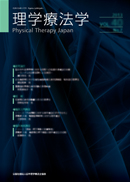Volume 34, Issue 8
Displaying 1-21 of 21 articles from this issue
- |<
- <
- 1
- >
- >|
The 42nd Annual Meeting of JPTA Keynote Lecture
-
Article type: Article
2007Volume 34Issue 8 Pages 313-315
Published: December 20, 2007
Released on J-STAGE: August 25, 2018
Download PDF (513K)
Invited Lecture
-
Article type: Article
2007Volume 34Issue 8 Pages 316-327
Published: December 20, 2007
Released on J-STAGE: August 25, 2018
Download PDF (1438K) -
Article type: Article
2007Volume 34Issue 8 Pages 328-334
Published: December 20, 2007
Released on J-STAGE: August 25, 2018
Download PDF (767K)
Educational Lecture
-
Article type: Article
2007Volume 34Issue 8 Pages 335-339
Published: December 20, 2007
Released on J-STAGE: August 25, 2018
Download PDF (669K) -
Article type: Article
2007Volume 34Issue 8 Pages 340-344
Published: December 20, 2007
Released on J-STAGE: August 25, 2018
Download PDF (812K)
Morning Seminar
-
Article type: Article
2007Volume 34Issue 8 Pages 345-348
Published: December 20, 2007
Released on J-STAGE: August 25, 2018
Download PDF (1279K) -
Article type: Article
2007Volume 34Issue 8 Pages 349-350
Published: December 20, 2007
Released on J-STAGE: August 25, 2018
Download PDF (276K)
Symposium
-
Article type: Article
2007Volume 34Issue 8 Pages 351-354
Published: December 20, 2007
Released on J-STAGE: August 25, 2018
Download PDF (718K) -
Article type: Article
2007Volume 34Issue 8 Pages 355-359
Published: December 20, 2007
Released on J-STAGE: August 25, 2018
Download PDF (728K) -
Article type: Article
2007Volume 34Issue 8 Pages 360-363
Published: December 20, 2007
Released on J-STAGE: August 25, 2018
Download PDF (672K)
Special Lecture: Bone and Joint Decade 2000-2010
-
Article type: Article
2007Volume 34Issue 8 Pages 364-369
Published: December 20, 2007
Released on J-STAGE: August 25, 2018
Download PDF (1150K) -
Article type: Article
2007Volume 34Issue 8 Pages 369-372
Published: December 20, 2007
Released on J-STAGE: August 25, 2018
Download PDF (865K) -
Article type: Article
2007Volume 34Issue 8 Pages 372-374
Published: December 20, 2007
Released on J-STAGE: August 25, 2018
Download PDF (668K)
Workshop
-
Article type: Article
2007Volume 34Issue 8 Pages 375-378
Published: December 20, 2007
Released on J-STAGE: August 25, 2018
Download PDF (1133K) -
Article type: Article
2007Volume 34Issue 8 Pages 378-380
Published: December 20, 2007
Released on J-STAGE: August 25, 2018
Download PDF (646K) -
Article type: Article
2007Volume 34Issue 8 Pages 380-381
Published: December 20, 2007
Released on J-STAGE: August 25, 2018
Download PDF (398K) -
Article type: Article
2007Volume 34Issue 8 Pages 381-383
Published: December 20, 2007
Released on J-STAGE: August 25, 2018
Download PDF (600K) -
Article type: Article
2007Volume 34Issue 8 Pages 383-384
Published: December 20, 2007
Released on J-STAGE: August 25, 2018
Download PDF (334K) -
Article type: Article
2007Volume 34Issue 8 Pages 385-389
Published: December 20, 2007
Released on J-STAGE: August 25, 2018
Download PDF (969K) -
Article type: Article
2007Volume 34Issue 8 Pages 390-394
Published: December 20, 2007
Released on J-STAGE: August 25, 2018
Download PDF (712K) -
Article type: Article
2007Volume 34Issue 8 Pages 395-400
Published: December 20, 2007
Released on J-STAGE: August 25, 2018
Download PDF (971K)
- |<
- <
- 1
- >
- >|
